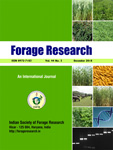MEKAPOTHULA SHANKAR REDDY, NEERAJ KHAROR*, SATPAL, SUSHIL NAGAR,
PUMMY KUMARI, BAJRANG LAL SHARMA, RAVISH PANCHTA, VISHAL CHUGH, VINOD KUMAR AND DALVINDER PAL SINGH
Department of Biochemistry, CCS Haryana Agricultural University, Hisar-125 004 (Haryana), India
Forage Section, Department of Genetics and Plant Breeding, CCS Haryana Agricultural University,
Hisar-125 004 (Haryana), India
Department of Basic and Social Sciences, College of Horticulture, Banda University of Agriculture and Technology,
Banda -210 001 (Uttar Pradesh), India
Division of Biochemistry, Faculty of Basic Sciences, Sher-e Kashmir University of Agricultural Sciences and
Technology of Jammu, Main Campus, Chatha, Jammu-180 009, India
*(e-mail: neerajkharor@hau.ac.in)
(Received : 3 March 2025; Accepted : 28 March 2025)
SUMMARY
Sorghum [Sorghum bicolor (L.) Moench], a drought-tolerant crop, holds promise for
addressing these feed challenges due to its high yield potential and adaptability to arid conditions.
This study examines the effect of varying fertilizer treatments on the growth parameters of two
single-cut sorghum varieties, HJ 541 and Duggi, under the semi-arid conditions of Hisar, India,
during the 2022 Kharif season. A factorial randomized block design (RBD) was employed with seven
fertilizer levels, including a 150% recommended dose of fertilizer (RDF), and analyzed across parameters
such as plant height, leaf count, fresh and dry biomass, and days to 50% flowering. Results
demonstrated that HJ 541 consistently outperformed Duggi in all growth parameters, with optimal
results observed at 150% RDF, which was statistically equivalent to 100% RDF for specific traits.
The findings underscore the importance of tailored fertilizer application in maximizing sorghum’s
growth potential, providing critical insights into addressing India’s forage deficit and enhancing
livestock productivity.
Key words: Sorghum, forage crops, fertilizer management, growth parameters, RDF, animal feed

